Auto Insurance
92% of Policyholders Who Recently Switched Auto Insurance Companies Saved Money, but Most Don’t Seek Additional Quotes
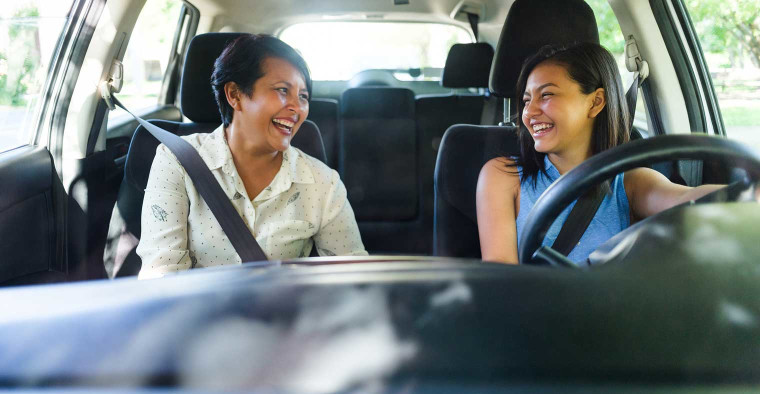
Rising gas prices throughout the U.S. have strained many household budgets. As a result, many Americans are reevaluating every auto-related expense — auto insurance premiums included.
Yet many auto insurance policyholders don’t shop around to ensure they’re getting the best deal possible where coverage is concerned. The latest ValuePenguin survey of more than 1,200 U.S. auto insurance policyholders finds that almost 40% saw their rates increase the last time their policy was renewed. But 65% of policyholders didn’t take steps to get quotes from other insurance companies.
- Key findings
- Most who switch auto insurance save money, but are enough Americans doing this?
- Why some consumers stay with their insurer — and whether they’re missing out on money
- Shopping around or not, nearly 4 in 10 auto insurance policyholders cite rate increases
- How Americans are combating auto insurance rate increases
- Methodology
Key findings
- 92% of auto insurance policyholders who switched companies during their most recent renewal period saved money. This impact was limited, however, as 65% of policyholders didn’t seek additional quotes during their renewal period.
- Consumers who generally don’t seek additional quotes might benefit from reconsidering their stance. 39% of consumers who didn’t switch auto insurance companies say theirs offers the best rates. But more than a quarter (26%) of those who recently switched to a new auto insurer saved $200 or more annually, which means those who don’t shop around may not have the full picture when they renew.
- Whether they shopped around, nearly 40% of auto insurance policyholders saw their rates increase during their most recent renewal period. According to ValuePenguin’s "State of Auto Insurance," rates were expected to increase by an average of 0.6% across the U.S. in 2022.
- To combat this, nearly 30% of those whose auto insurance rates went up decreased their coverage to save money. While dropping comprehensive insurance lowers your premiums, a March 2022 ValuePenguin survey found that many consumers mistakenly think they’d be covered for car theft or theft-related damage.
Most who switch auto insurance save money, but are enough Americans doing this?
The vast majority of policyholders who switch auto insurance companies save money (92%). And that potential savings can be meaningful, with 26% of policyholders saving $200 or more a year after moving their auto insurance coverage to a new provider (more on this later).
But despite this, most policyholders (65%) don’t get outside quotes for comparison when their auto insurance policies are up for renewal. By region, a higher percentage of policyholders in the Northeast (70%) and West (69%) aren’t shopping around.
Age also appears to play a role in how likely a person is to shop around for better auto insurance rates. Baby boomers — ages 57 to 76 — are most likely not to shop for a lower rate before their policy renewal at 77%. Here’s a closer look:
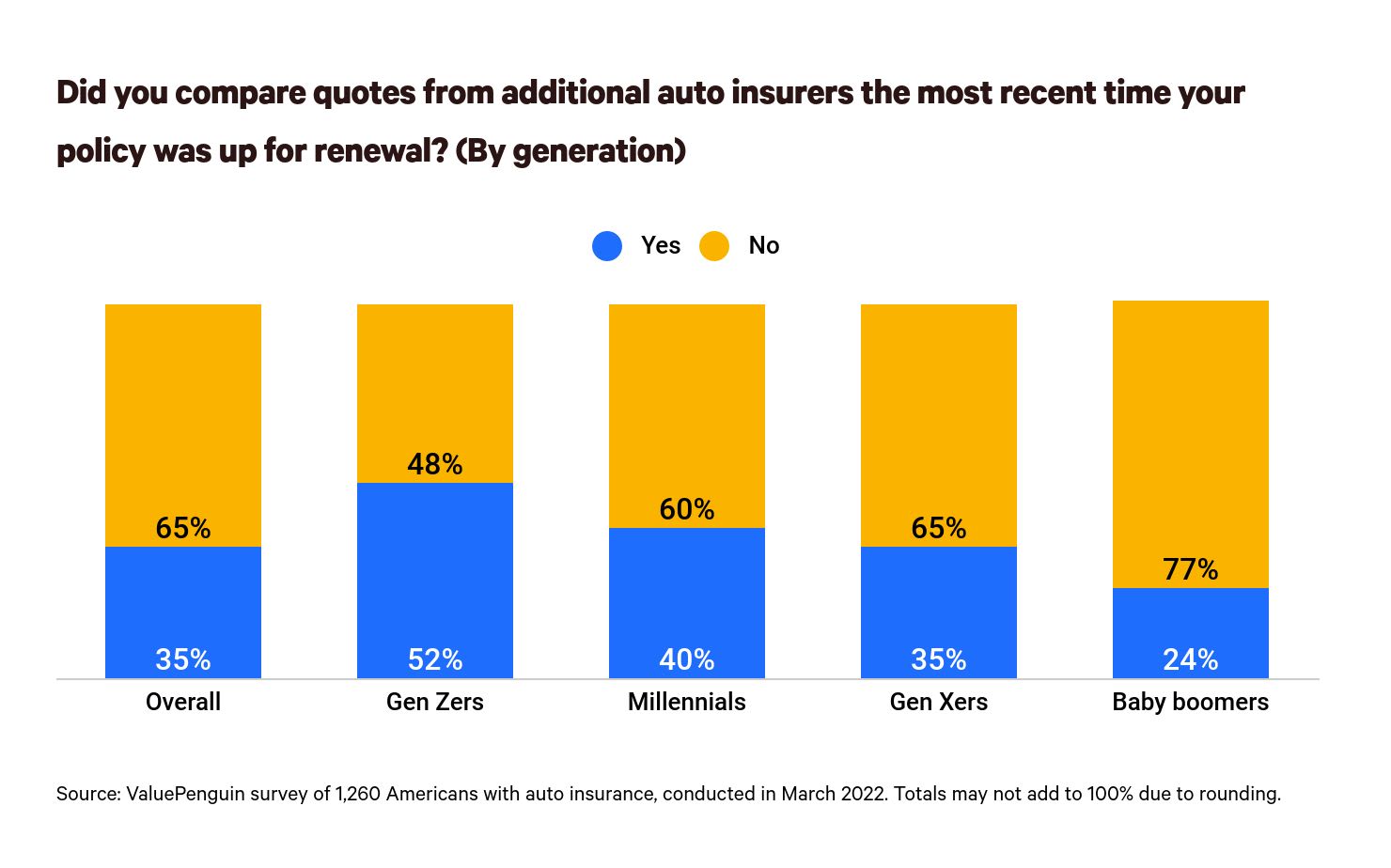
Even starker, just 48% of consumers whose auto insurance rates increased during their most recent renewal shopped around for lower insurance premiums. That means the majority didn’t take the time to compare insurance companies — even after their rates rose.
When policyholders shop for additional quotes after a rate increase, they go about the process differently. Here’s how their most recent renewal went:
- 28% checked rates with just one other insurance company
- 13% got quotes from two insurance providers
- 7% made an effort to get three or more quotes from competing insurers
Interestingly, most policyholders (80%) stuck with their original insurer even after shopping around for a lower rate. In fact, 89% of consumers whose rate increased remained with the same auto insurance provider.
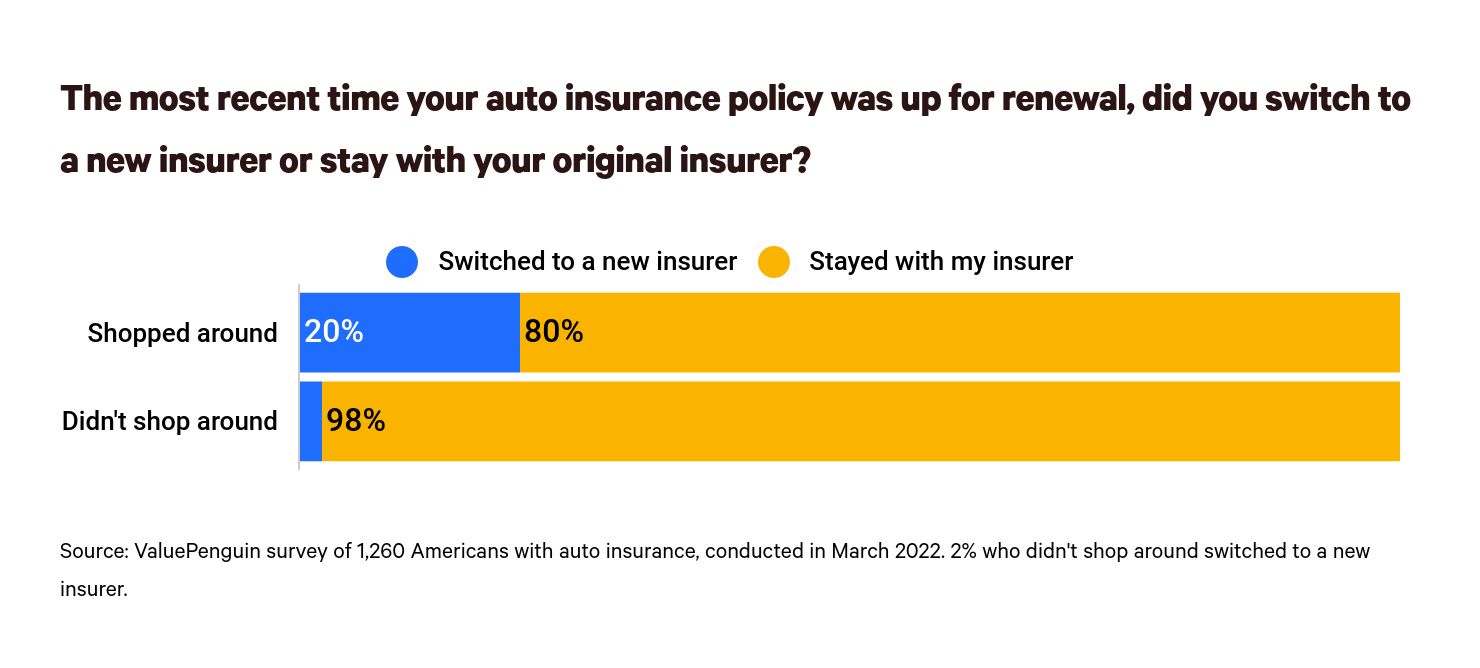
Why some consumers stay with their insurer — and whether they’re missing out on money
Overall, most policyholders (92%) stayed with the same auto insurance provider during their most recent policy renewal. Yet the reasons that motivated people to stay put with their auto coverage were varied.
Across all policyholders, 39% who didn’t switch auto insurance companies say theirs offers the best rates. Specifically among policyholders who shopped around for a lower insurance premium:
- 47% decided to stay with their original insurer because it offered the lowest rates
- 35% stayed with the same insurer because they liked the customer service support
- 30% didn’t change policies because they bundle auto and home insurance
- 11% put off making a change due to the hassle of switching insurance providers
As for those who didn’t change insurance providers after a rate increase, most (40%) decided not to make a change due to the bundling of their auto policy with home insurance.
When people change auto insurance carriers, most (92%) are rewarded with lower premiums, as we noted earlier. The amount of money that consumers may save from the switch can vary, but the annual savings comes in between $50 and $99 annually for the largest group (28%).
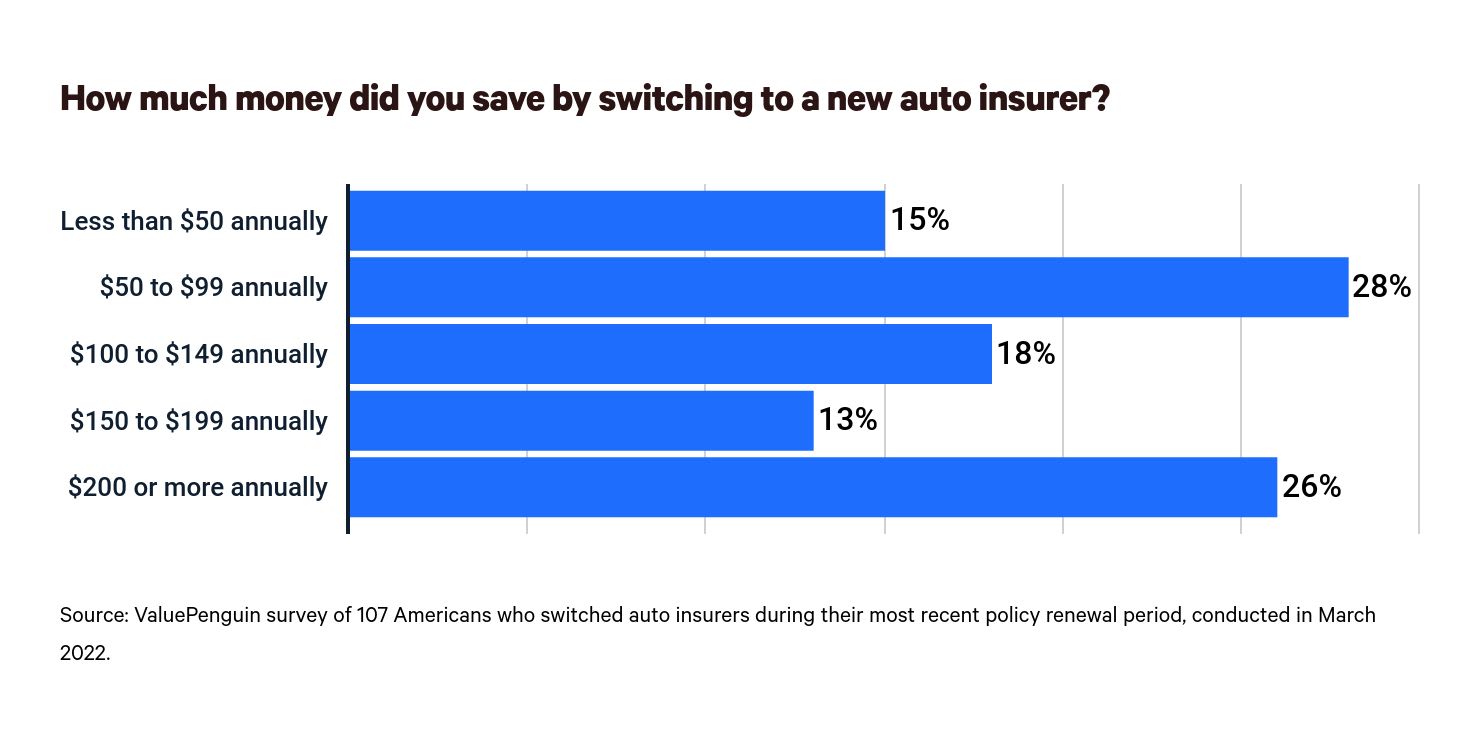
It’s no surprise that those who switched to a new auto insurer primarily did so to save money (84%). Yet there are other motivations for change. A desire to try out a new insurer because they heard good things about it (20%) and dissatisfaction with their previous insurance company’s customer service (14%) are two other popular reasons people change insurance providers.
Shopping around or not, nearly 4 in 10 auto insurance policyholders cite rate increases
Rates increased at renewal for close to 40% of auto insurance policyholders. And another 10% of policyholders didn’t know whether their rates went up.
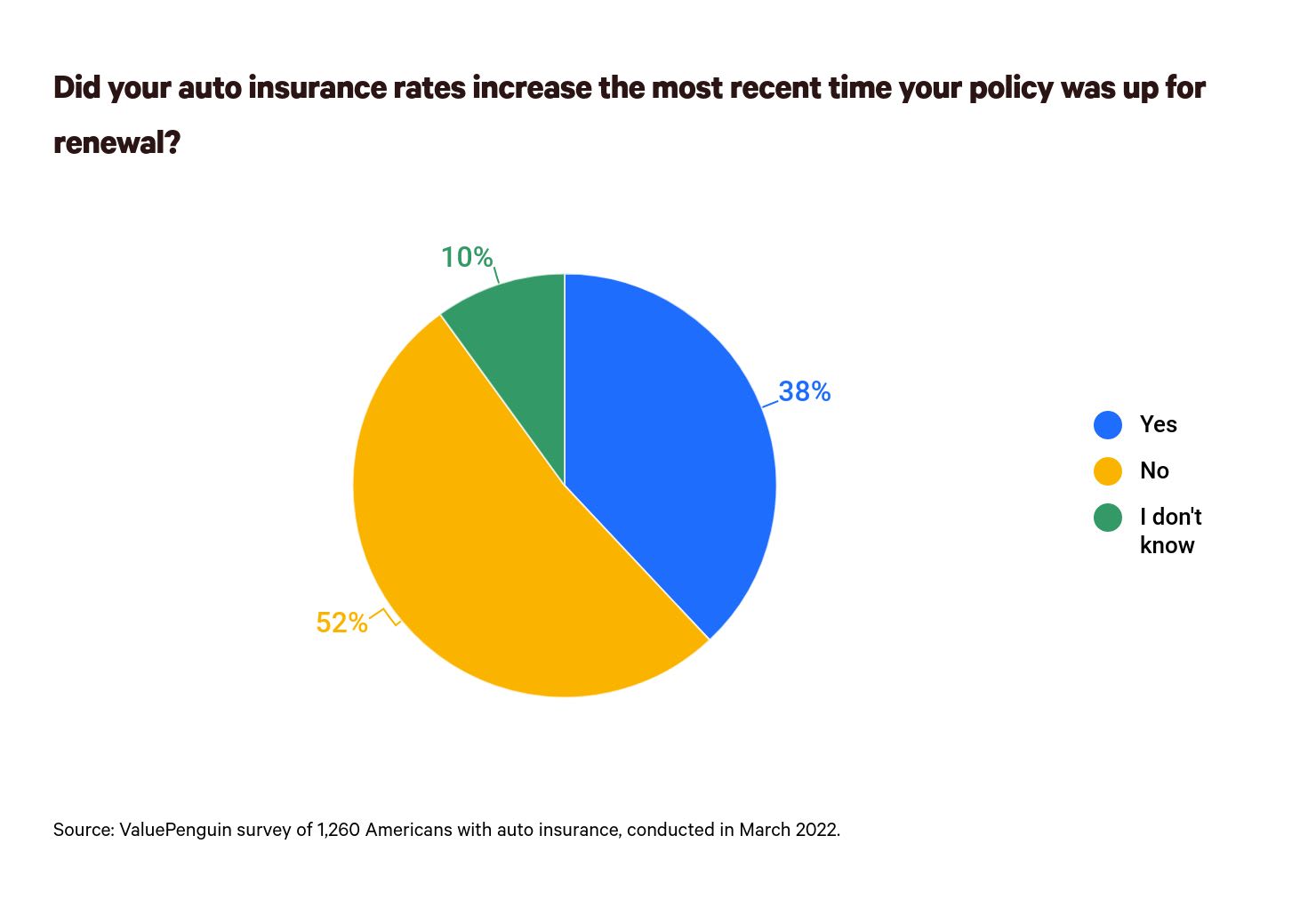
Increases in auto insurance premiums can be common. ValuePenguin’s "State of Auto Insurance" predicted that 2022 auto insurance rates could increase by 0.6% on average throughout the U.S. And the expected increase could hit some consumers harder than others.
When asked whether they were struggling to afford their auto insurance premiums, 46% answered yes. Women (52%) were more likely than men (40%) to say that auto insurance premiums were putting their household budget under stress.
The ability to afford auto insurance coverage differs among various age groups, too. The percentage of people who struggle to cover auto insurance costs by generation is as follows:
- Gen Zers (ages 18 to 25): 60%
- Millennials (ages 26 to 41): 51%
- Gen Xers (ages 42 to 56): 47%
- Baby boomers: 34%
Residents of the Northeast admit to struggling to afford auto insurance coverage more than people in other areas of the country. The difference isn’t huge, but nearly half of policyholders in the Northeast (49%) have difficulty paying for auto insurance. By comparison, 44% of people in the Midwest and West feel the same.
How Americans are combating auto insurance rate increases
Even though most Americans (89%) hold steady with their auto insurance providers after a rate increase, many people take other actions to try to offset higher costs. In particular, 61% of policyholders who saw a rate increase have contemplated decreasing their coverage by switching to liability-only car insurance, dropping add-ons and more. Of this group, 27% have gone beyond contemplation and decreased coverage.

Overall, not everyone who contemplated decreasing coverage moved forward. More than one-quarter (29%) of policyholders decided not to adjust their coverage to save money. But 16% did opt for less coverage after weighing their options.
Some of these consumers who reduced their coverage might be confused about how a lack of comprehensive insurance could impact their lives. A recent ValuePenguin survey found that many people have a mistaken belief that liability coverage will protect against car theft and damage from such events.
Another way that many consumers try to save money is by bundling their auto insurance and home insurance together — 55% say they do this. Households with an annual income of $75,000 to $99,999 were most likely to bundle (67%). On the other end of the spectrum, households that earn less than $35,000 a year were the least likely to take advantage of this potential savings opportunity (43%).
More than a quarter of those who bundle their insurance policies together say auto insurance was more important than home when selecting a provider. Yet most policyholders (60%) felt that both auto insurance and home insurance were of equal importance, and they made sure to choose an insurer they believed would provide the best of both types of coverage.
Methodology
ValuePenguin commissioned Qualtrics to conduct an online survey of 1,260 consumers with an auto insurance policy, March 17-24, 2022. The survey was administered using a nonprobability-based sample, and quotas were used to ensure the sample base represented the overall population. All responses were reviewed by researchers for quality control.
We defined generations as the following ages in 2022:
- Generation Z: 18 to 25
- Millennial: 26 to 41
- Generation X: 42 to 56
- Baby boomer: 57 to 76
While the survey also included consumers from the silent generation (those 77 and older), the sample size was too small to include findings related to that group in the generational breakdowns.
